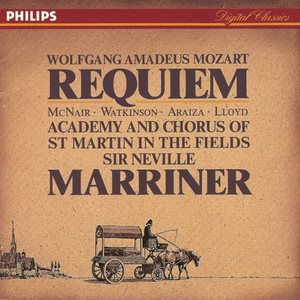Born in Salzburg, then in the Holy Roman Empire and currently in Austria, Mozart showed prodigious ability from his earliest childhood. Already competent on keyboard and violin, he composed from the age of five and performed before European royalty. His father took him on a grand tour of Europe and then three trips to Italy. At 17, he was a musician at the Salzburg court but grew restless and traveled in search of a better position.
While visiting Vienna in 1781, Mozart was dismissed from his Salzburg position. He stayed in Vienna, where he achieved fame but little financial security. During his final years there, he composed many of his best-known symphonies, concertos, and operas. His Requiem was largely unfinished by the time of his death at the age of 35, the circumstances of which are uncertain and much mythologized.
Agnus Dei
Wolfgang Amadeus Mozart Lyrics
Jump to: Overall Meaning ↴ Line by Line Meaning ↴
dona eis requiem.
Agnus Dei, qui tollis peccata mundi,
dona eis requiem sempiternam.
The lyrics to Wolfgang Amadeus Mozart's song Agnus Dei is a Latin text that translates to English as "Lamb of God, who takes away the sins of the world, grant them rest. Lamb of God, who takes away the sins of the world, grant them eternal rest." The song is a part of the liturgy of the Catholic Mass, specifically during the Fraction Rite, which is the breaking and distribution of the Communion bread.
Mozart's version of Agnus Dei is a serene and peaceful song that reflects the prayerful and introspective nature of the Catholic Mass. The repetition of the phrase "dona eis requiem" (grant them rest) emphasizes the need for spiritual peace and rest, which is ultimately achieved through the forgiveness of sins. Mozart's composition of this song creates a sense of transcendental solemnity and reverence, which aligns with the purpose of the Mass as a form of spiritual devotion and communion with God.
Line by Line Meaning
Agnus Dei, qui tollis peccata mundi,
O Lamb of God, who takes away the sins of the world,
dona eis requiem.
grant them rest.
Agnus Dei, qui tollis peccata mundi,
O Lamb of God, who takes away the sins of the world,
dona eis requiem sempiternam.
grant them eternal rest.
Contributed by Colin B. Suggest a correction in the comments below.

Krzysztof Przewoźny
Cudowne wykonanie. Wgniata w fotel. Brawo!
Karel Lojka
Nice and perfect solo. Bravo Olga !
Willem Tates
It is Brava
Koos Nolst Trenite
Beautiful, perfect.
Also a wonderful recording (video and sound)
Wieger van der Weerd
Geweldige muziek! En Olga op haar best! Bravo!
Estelle B
Respect! It's very beautiful. Bravo !!!
loriloristuff
Brava, brava, bravissima!!!!
Inna Dikoun
bravo Olga!
Johan Koomen
great Olga...
Jan Wouda
As good as Karajan and Battle